This Johnson County woman owns over 1,000 Black Barbies. You can see her soon on HGTV
When Sonya Larson needs to escape to her happy place, she just walks down a few steps into the basement of her Olathe split-level and sits in a windowless room with bright pink walls where hundreds of Black dolls in boxes are neatly lined up on shelves, floor to ceiling.
It’s her Barbie Room.
Some people think it looks more like a Barbie store.
It is the manifestation of an obsession that began three decades ago and has become what Larson believes to be among the largest collections of Black Barbies in the country.
The country will meet Larson in the coming weeks when she appears on HGTV’s “Barbie Dreamhouse Challenge,” a new Sunday night decorating competition tied to Friday’s opening of the “Barbie” movie starring Margot Robbie as the doll and Ryan Gosling as her accessory, Ken.
Larson hasn’t taken inventory but guesses she owns more than 1,000 Black Barbies, including hundreds stashed away in plastic bins. She has doubles and triples of some dolls.
She owns Black Barbies with skin tones ranging from deep ebony to caramel. They wear holiday gowns, swimsuits, cheerleader uniforms and pajamas. She has a Julia the TV nurse Barbie, the Ella Fitzgerald and Tina Turner Barbies, Albino Barbie, the bald Black Barbie recovering from cancer, a Black Barbie in a wheelchair and one with a prosthetic leg.
Her sentimental favorite is a 1984 Black Peaches ‘N Cream Barbie, wearing its iconic ruffly stole of tulle, the one doll Larson wanted so much as a little girl but had to buy for herself as an adult.
And high on a shelf across the room is the unfortunate “Oreo” Barbie released in 1997. (More about that soon.)
Oh, Mattel.
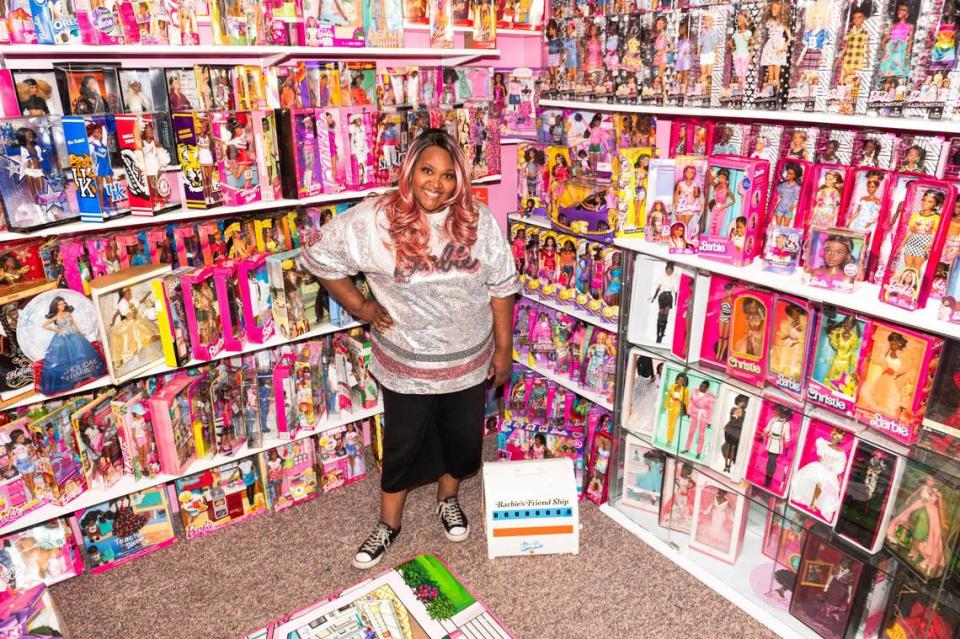
“I just started really looking at them and seeing how beautiful they were. And once I started putting them up … that made me so happy,” Larson said, glittering in a sequined Barbie jersey from Forever 21 as she recently showed The Star her collection.
“I mean, you can’t just walk in here and feel sad because … there’s so much beauty in this room.”
If Larson wins on the HGTV show, she will be crowned a Barbie Superfan. But the woman who says that “very seldom do you find me not doing something related to Barbie” doesn’t need HGTV to give her that title. Right now she’s organizing two fundraising “Barbie” movie parties for Friday and Saturday.
“When I was speaking to the casting director for the HGTV episode, he said what would it mean if you won, if you were named Barbie Superfan,” said Larson, who is 48.
“I said for me, as a Black female … I’m not supposed to love this doll. And a lot of people don’t get that. People don’t understand why I love Barbie. She’s blond. She’s skinny. She’s got blue eyes. Why do you love her?
“It’s because she’s everything. She is my best friend. She is a great role model and people don’t think that. But she can be anything and she can teach you to be anything.
“I guess I can’t understand why people don’t see it. Like people who love ‘Star Wars’ and collect action figures, it’s for the love of the doll.”
So bring on the Barbie haters.
Larson believes director Greta Gerwig’s movie will win fans for the controversial doll. She is especially happy that Black actress Issa Rae plays President Barbie in the movie. Today Mattel makes Barbies in numerous skin tones and body types.
“Barbie is that villain that people love to hate,” Larson said. “Some people just hate her because she’s Barbie. Because again, she’s always had this image of being thin and her tiny, tiny little waist, and ‘I’m not your Barbie doll.’
“If you hate Barbie, watch this movie because you’ll love her. Because you will gain a respect for Barbie that you never would have thought you had.”
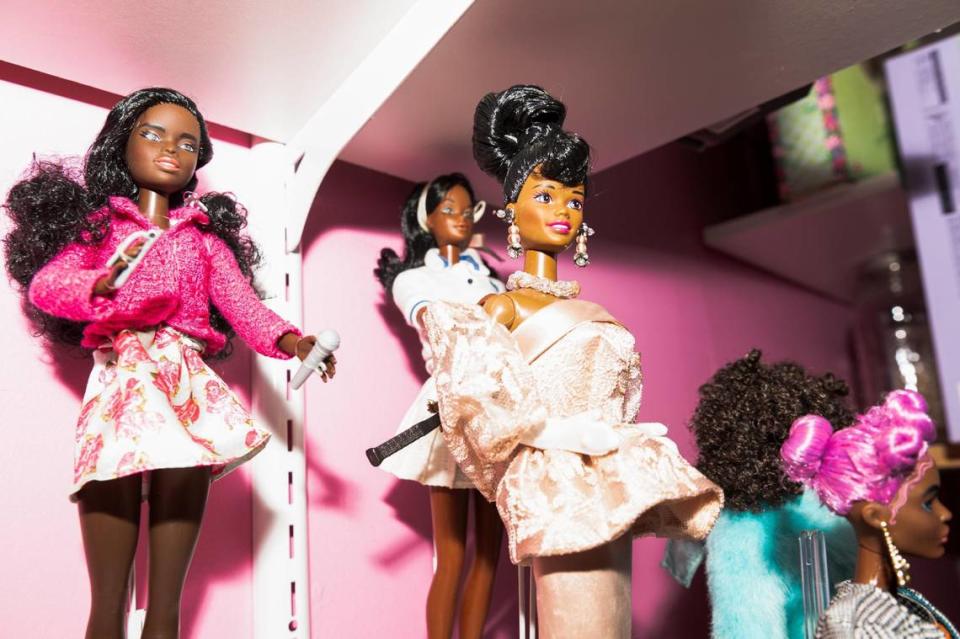
‘She’s black!’
Collecting only Black Barbies is challenging, Larson said. For one thing, they are harder to find than white Barbies and usually cost more. And new Barbies are released all the time, making it difficult to keep pace.
She didn’t get many Barbies as a little girl growing up in Texas. Larson’s mom wouldn’t buy a doll that didn’t look like her daughter, and finding a Black Barbie was near-impossible in the mid-’80s.
Mattel released the first Black Barbie in 1980, some 20 years after Barbie came on the scene. Designer Kitty Black Perkins, who is Black, gave her curly black hair and put her in a dress that was red instead of Barbie pastel. The box proclaimed: “She’s black! She’s beautiful! She’s dynamite!”
The doll had been introduced earlier as Barbie’s friend Christie in 1968, but Perkins’ creation was the first Black doll to be named Barbie. “She wanted little girls to say you can be Barbie, because there were little Black girls named Barbara who went by Barbie,” said Larson.
From the time of her introduction in March 1959, Barbie was promoted as a doll that could be anything — college graduate, astronaut, surgeon, engineer, president. “But I never saw her in a Black form,” Larson said. “I’m thinking only little white girls can be this? So that’s why representation matters.
“Because when you see someone that’s doing something that you want to do that looks like you, that talks like you, that comes from where you came from. It’s easy for you to believe that ‘well, I can make it.’
“But if you’re not able to see anything that looks like you, you’ll never believe that.”
When Larson turned 16 and got her first job, she decided that if she ever had a daughter of her own, “my little girl would never feel like I felt,” she said.
She visited the Barbie aisle at a Toys R Us and lo! There were Black Barbies.
Her tip for beginners: That’s a good place to start a collection, with inexpensive Barbie Playline dolls.
She can’t pinpoint when her doll-buying became an obsession, a word she doesn’t shy from. She compares it to weight that creeps up on a body: “It just kind of happened,” she said.
Just kind of happened to the point where this wife and mother of three works two jobs, at a local hotel and as an event planner, to support her hobby. She hasn’t estimated the value of her collection.
Collectors of Black Barbies remain a minority subset in the doll collecting world, said Larson, who recently returned from the National Barbie Doll Collectors Convention in Orlando, where she took a class on how to customize Barbies with Black hairstyles.
She is currently looking for sponsors to host a mini-convention of Black Barbie collectors in Kansas City next year. In September she’s heading to The Strong National Museum of Play in Rochester, New York, to learn more about Black Barbie and Black dolls and find speakers for a possible KC gathering.
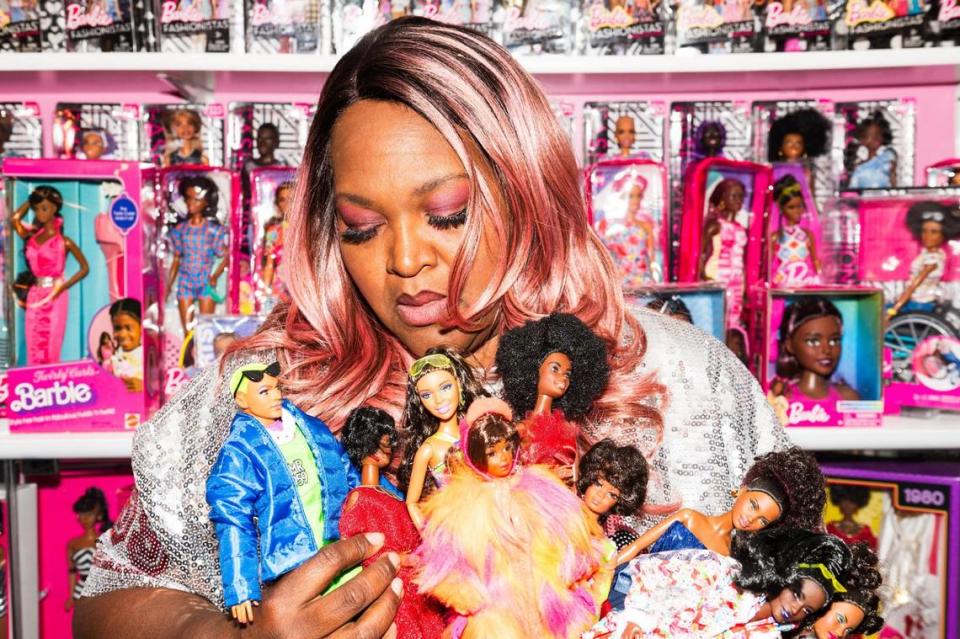
Goddess of Africa
Larson has instructed her family that when she dies, her Goddess Barbie is not to be sold.
Her 1999 Fantasy Goddess of Africa Barbie, one of only 20,000 made, was designed by the legendary Bob Mackie, who created Cher’s elaborate wardrobe.
Dressed in the “colors of a Serengeti sunset,” Fantasy Goddess wears a heavily embroidered and beaded gown, beaded forearm cuffs, a dramatic golden collar and a headpiece of orange and red feathers.
In Larson’s Barbie Room, the Goddess holds court on the bottom shelf of a lighted display case. With dramatically arched eyebrows, almond-shaped eyes and red lips, she is as regal as 11 inches of plastic can be.
Larson buys the Barbies wherever she can find them — online, from other collectors, at auctions. She mentions one Kansas City auctioneer popular with Barbie collectors. People come here to buy from him.
“There’s this one lady from D.C. that we all (dislike) but it’s because she spends a lot,” Larson said. “She drops $8,000, $9,000 and she’s there (at auction) very time. There’s a lot of money in collecting.”
It’s all about the face for Larson when she buys a Barbie. It took Mattel a few attempts before figuring out they couldn’t just use a white Barbie face for a Black Barbie, she said. Now there are several Barbie face molds, some more popular than others. Collectors have their favorites.
The Goddess Face Sculpt, used mostly for Black Barbies, is one of the most prized among collectors, Larson said. “Sometimes I just look at a doll and go, ‘Oh my God, she’s gorgeous.’ Some of them speak to me,” she said.
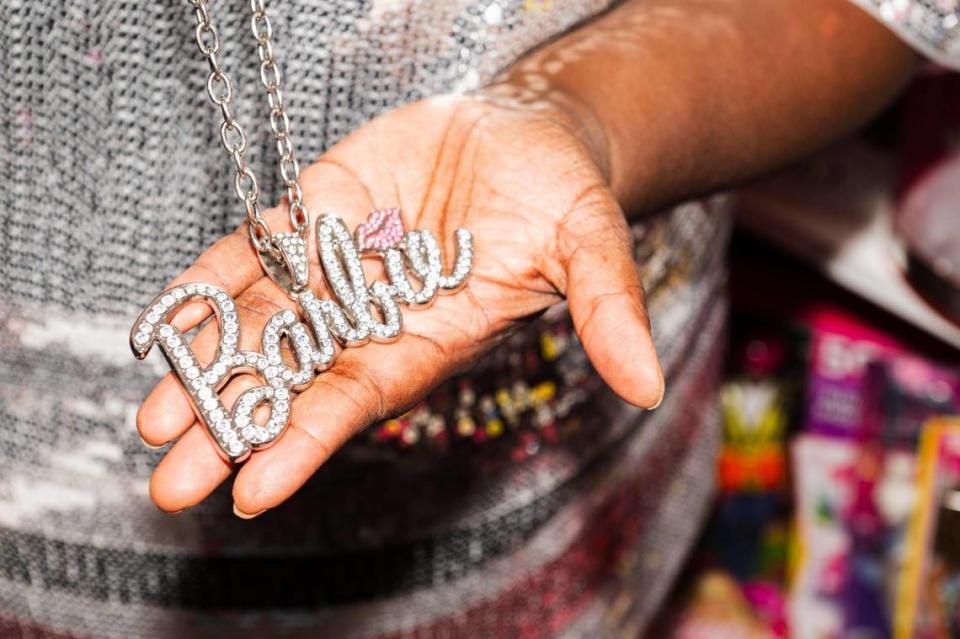
Ruth’s doll
Ruth Handler, who with her husband, Elliot, and business partner Harold Matson founded toy company Mattel in 1945, created Barbie.
The documentary “Tiny Shoulders: Rethinking Barbie” about Barbie’s biggest makeover in 2016, explores how Handler, the daughter of Jewish immigrants, was a lone woman working in a man’s world who wanted to give girls more than baby dolls and paper dolls to ignite their imaginations. At the time, “there was not a fashion doll,” said Larson.
Along came Handler’s Barbie who had womanly breasts — gasp! — and, when she wasn’t hosting a slumber party, worked jobs that didn’t have anything to do with raising children or keeping house, two things businesswoman Handler herself did not enjoy, according to the documentary.
Handler believed that girls in the 1950s didn’t want to just be mothers and wanted Barbie to reflect other options.
“My whole philosophy of Barbie was that through the doll, the little girl could be anything she wanted to be. Barbie always represented the fact that a woman has choices,” Handler wrote in her 1994 autobiography.
But Barbie and her humanly unrealistic proportions became a lightning rod for criticism. The Slumber Party Barbie of 1965, with satin pajamas, pink open-toe high heels, a cardboard scale that read 110 pounds and a “How to Lose Weight” book didn’t help.
“She was everything we didn’t want to be, but were being told to be,” feminist Gloria Steinem said in the “Tiny Shoulders” documentary.
But Larson, of Generation X, never saw Barbie that way.
“That’s why Barbie has all these jobs so that girls could see that they can be anything and everything. That’s why she (Handler) did that, so they could play,” Larson said. “Barbie went to space before man went to space, you know.”
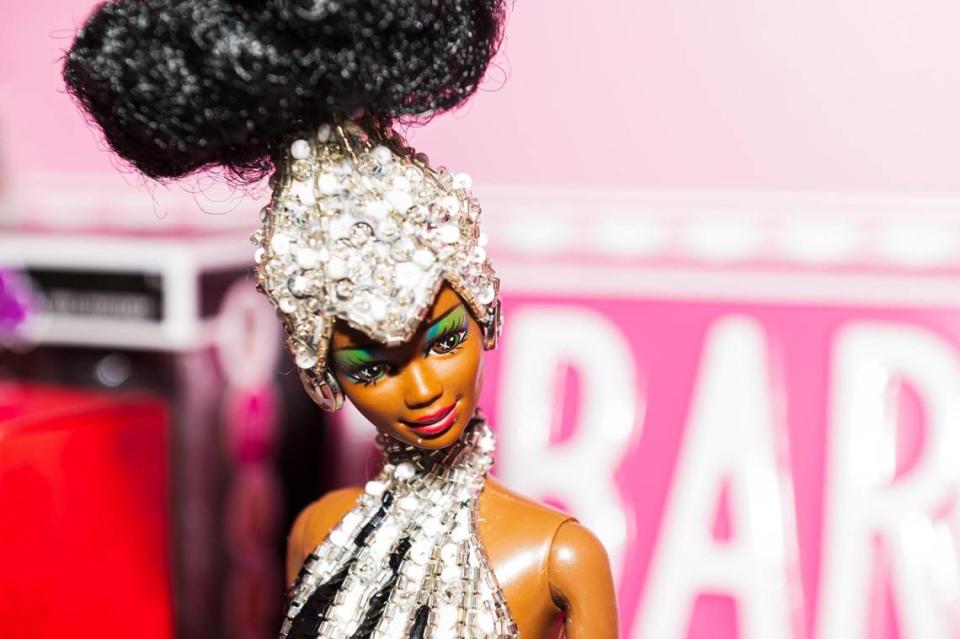
She believes that “now we as a society, we’re ready to see Barbie in a different way.”
Consider Barbie’s participation in the racial unrest that roiled the country during the summer of 2020, Larson said. Barbie became engaged in the discussion.
In a story line in “Barbie Life in the Dreamhouse” on Netflix, Barbie’s Black friend, Nikki, had a run-in with police that led to a child-friendly discussion of being targeted because of race.
“Who would have ever thought, Barbie?” said Larson.
That’s light years from the introduction of one of the most controversial Barbies of all time — Oreo Barbie.
As a cross promotion with Nabisco, Mattel created a white Oreo cookie Barbie sold only in grocery stores that flew off the shelves in 1994. Because it was so popular, Mattel released a Black Oreo Barbie three years later.
It took a hot second for people to point out how derogatory it is to call a Black person an “Oreo.” (“Black on the outside but white on the inside.”)
“So this doll got pulled off the shelf and if you got one, good luck getting it for under $150, $200,” Larson said.
The Oreo Barbie is one of her most expensive dolls.
Larson, who has three sons, will turn 50 in two years and plans to treat herself with her very own Barbiemobile.
Hers will be a Volkswagen Beetle custom-painted in — what else? — Barbie pink.
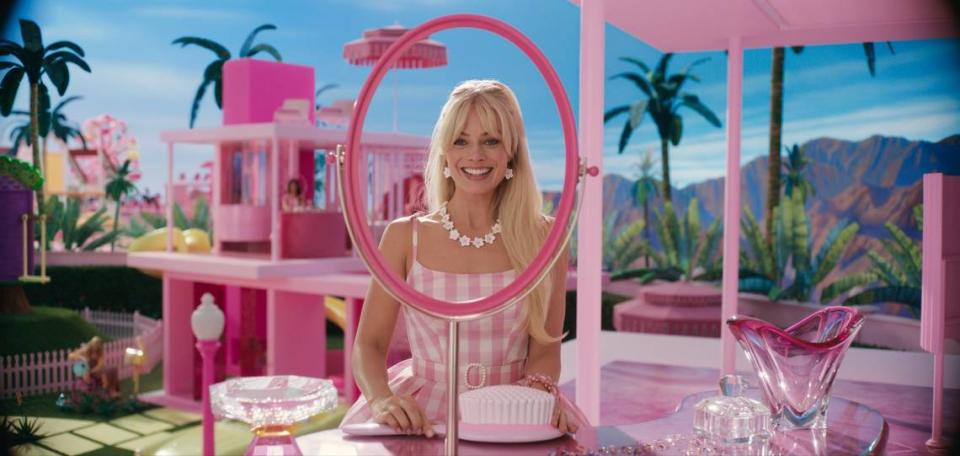
Barbie Movie Party and Toy Drive
What: Fundraiser for the Barbie Dream Gap Project, a global initiative that works with charities to help girls get resources they need to live their dreams. Special emphasis this year is on BIPOC (Black, Indigenous, People of Color) girls.
When: 7 p.m. Friday, B&B Theatres, 16301 Midland Drive, Shawnee; 7 p.m. Saturday, B&B Theatres, 3241 S.W. Fascination Drive, Lee’s Summit.
Toy drive: Bring a toy that will be distributed to local children during the holiday season.
Cost: $25, includes movie admission. Tickets at eventbrite.com.

